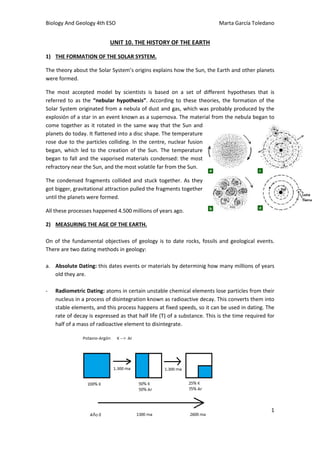
Historyoftheearth
- 1. Biology And Geology 4th ESO Marta García Toledano UNIT 10. THE HISTORY OF THE EARTH 1) THE FORMATION OF THE SOLAR SYSTEM. The theory about the Solar System’s origins explains how the Sun, the Earth and other planets were formed. The most accepted model by scientists is based on a set of different hypotheses that is referred to as the “nebular hypothesis”. According to these theories, the formation of the Solar System originated from a nebula of dust and gas, which was probably produced by the explosión of a star in an event known as a supernova. The material from the nebula began to come together as it rotated in the same way that the Sun and planets do today. It flattened into a disc shape. The temperature rose due to the particles colliding. In the centre, nuclear fusion began, which led to the creation of the Sun. The temperature began to fall and the vaporised materials condensed: the most refractory near the Sun, and the most volatile far from the Sun. The condensed fragments collided and stuck together. As they got bigger, gravitational attraction pulled the fragments together until the planets were formed. All these processes happened 4.500 millions of years ago. 2) MEASURING THE AGE OF THE EARTH. On of the fundamental objectives of geology is to date rocks, fossils and geological events. There are two dating methods in geology: a. Absolute Dating: this dates events or materials by determinig how many millions of years old they are. - Radiometric Dating: atoms in certain unstable chemical elements lose particles from their nucleus in a process of disintegration known as radioactive decay. This converts them into stable elements, and this process happens at fixed speeds, so it can be used in dating. The rate of decay is expressed as that half life (T) of a substance. This is the time required for half of a mass of radioactive element to disintegrate. 1
- 2. Biology And Geology 4th ESO Marta García Toledano b. Relative dating: this puts rocks, fossils or events in chronological order, without specific exact dates. The history of the Earth is like a book, and each page corresponds to a sediments stratum or layer. The deposit or sedimentation of layers happens periodically, and, to reconstruct the history of our planet, a geologist has to put these layers in order. There are two main principles that are used to determine the relative age of a stratum: - The Principle of Superposition: each layer is younger than the one below it, and older than the one above it. - The Principle of Cross-cutting Relationships: an event, such as a fault or a fold, is younger tan the rocks it affected, and older thanthe rocks it didn’t affect. In this image, stratum H, I, A, G and C are affected by the fold, so they must be older than it. Stratum D, E and F are not affected by the fold, so it happened before they were deposited. 3) FOSSILS. Paleontology is the part of geology that studies fossils. Fossils are the remains of living beings or their activity, preserved in rocks. Fosilisation is a rare occurrence, because normally the remains dissapear without trace. The majority of fossils come from the most resistant and hardest parts of an organism. The Principle of Faunal Succession: each period in the history of the Earth can be classified by a type of characteristic plant and animal fossil. Fossils are used by geologist because they provide two types of information: a. Temporal information: species evolve and change. A fossil species will only appear in rocks for a specific period of time in the Earth’s history. This means that the species or rocks can be dated. b. Paleoecological information: living things are adapted to specific types of environments, so we can use fossils to learn about the environmental conditions of a particular age. 2
- 3. Biology And Geology 4th ESO Marta García Toledano Index Fossils are particularly interesting and useful fossils, as they are the fossils of species that existed for short periods of time over large areas. Trilobites have been found on stratum N, and we know they were a kind of arthropod who live between 570 – 250 millions of years ago. So, this stratum can be dated by that time. Besides, they were aquatic animal, so we can affirm this zone was submerged under the sea by that time. 4) THE CHANGING EARTH. Earth is not static. In geological time, events and changes occur continuously. In the 18th and 19th centuries, there were two opposing theories about the intensity of the changes that occurred in the Earth’s history: Catastrophism and Uniformitarianism. a. Catastrophism: Cuvier proposed this theory, base don the supposition that there had been sudden catastrophes that, in a short space of time, had changed the Earth completely. b. Uniformitarianism: Lyell mantained that slow, imperceptible changes over millions of years could produce enormous alterations. Today many geologists believe that the changing nature of the Earth’s surface can be explained in part by both theories. This viewpoints suggests that the changes are mostluy due to slow gradual processes, but that rare violent events, such as a meteor impact, can also affect the planet. The changes which affect the Earth can be: - Climate changes: in the Earth’s history, warm stages alternate with glacial periods. Sea level changes: when the sea rises, it covers the continents; when it falls, submerged land become exposed. Paleogeographic changes: changes in the distribution of continents and oceans because of plate tectonics. Changes in biodiversity: there are periods when the number of species increases, ofetn followed by periods of sudden massive extinctions. 3